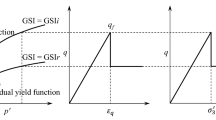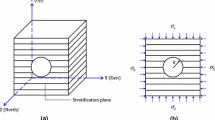Conclusions
-
1.
The experiment that we conducted confirmed the earlier existing hypothesis concerning the development of a prestressed state in the rock surrounding a tunnel lining as a result of pressure grouting.
-
2.
The prestressed state of the rock was found to be 15–20% lower than the injection pressure during all stages of and immediately following the injection.
-
3.
Immediately after grouting, and for the next 2 days, the compressive stresses in the lining were, on the average, 25–30% higher than those in the rock mass. Later on, this difference was reduced to 5%, and stabilized.
-
4.
The basic relaxation of prestress in the rock and lining occurs during the first 10 days after grouting.
-
5.
Three months after grouting, the prestress state of the rock and lining is virtually stable, having been reduced by a factor of 1.5–2 at this time.
Our experiment is peculiar in nature for the case of an isotropic rock mass of average toughness with group (simultaneous) injection of an entire tunnel section and demonstrates only the practical feasibility of developing prestress in the rock mass around a tunnel. Comprehensive field studies for different engineering-geologic situations are absolutely necessary to the broad utilization of this effect in tunnel construction.
Similar content being viewed by others
Literature cited
V. S. Éristov and A. M. Mazur, Subsurface Operations and Improvement in the Rock Foundations of Dams [in Russian], Énergiya, Moscow (1966).
M. Buvard and N. Pino, Pressure Tunnels and Shafts at the Capivari-Cachoeira Hydraulic Facility (Brazil) [Russian translation], Orgénergostroi, Moscow (1972) (Translation No. 2859).
VB. Kujundzic, L. Iovanovic, and Z. Radoslavievic, Solution du zevêtement d'une galerie en charge par application d'injectionsa haute pression, Rapports du Deuxième Congres de la Societé Internationalede Mécanique des Roches, Vol. 11, Theme 4, Belgrade (1970).
M. Pavlovic, “Grouting work on the headwater tunnel for the Rama hydroelectric plant,” Rapports du Deuxième Congres de la Societé Internationalede Méchanique des Roches, Vol. 11, Theme 4, Belgrade (1970).
A. M. Gobechiya, Efficiency of Grouting Rock Surrounding High-Pressure Hydraulic Tunnels for Hydroelectric Plants [in Russian], GruzNIIÉGS, Tbilisi (1972).
P. U. Ponimatkin, “On the effective depth of grouting in pressurized hydraulic tunnels,” Gidrotekh. Stroit., No. 4 (1969).
G. Ya. Pochtovik, A. B. Zlochevskii, and A. I. Yakovlev, Methods and Means of Testing Structural Designs [in Russian], Vysshaya Shkola, Moscow (1973).
V. L. Kubetskii, “A study of the stressed state developed in the mass and surrounding design by grouting,” in: Coll. of Proc.of the V. V. Kuibyshev Moscow Order of Red Labor Banner Civil Eng. Inst. [in Russian], No. 140, Moscow (1977).
Additional information
Translated from Gidrotekhnicheskoe Stroitel'stvo, No. 3, pp. 20–23, March, 1979.
Rights and permissions
About this article
Cite this article
Churakov, A.I., Zhokhov, E.I. Model studies of prestress in the rock mass surrounding a tunnel excavation. Hydrotechnical Construction 13, 245–249 (1979). https://doi.org/10.1007/BF02308017
Issue Date:
DOI: https://doi.org/10.1007/BF02308017




